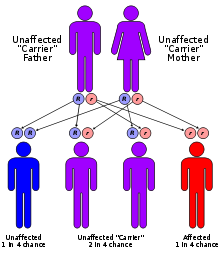Inheritance of the mutationMCAD deficiency is a disorder that is inherited in an autosomal recessive pattern. That means that both girls and boys can inherit the disorder (automsomal) and that one only has the disorder if both copies of the gene on the pair of chromosomes (also called alleles) have the mutation (recessive). In
autosomal recessive inheritance of a disorder, both parents have each
one mutation, and the patient received from both parents the mutated
gene. It is also possible that a mutation is newly created in the sperm cell or egg cell from which the baby originated. In that case the baby has the disorder and can pass it on to his or her children. But the parent is not a carrier.  So in a next pregnancy for two parents who are carriers there is:
Many
patients with MCAD deficiency have the same mutation on both alleles
(usually the "classic" A985G mutation). They are said to be homozygous for this mutation.
A carrier has a mutation on one allele and a normal version of the other allele. The carrier is called heterozygous. When a patient has two different mutations on the two alleles, this is called compound heterozygous. Read further about the consequences >
|
||||
|
|
This page was last modified on 5 March 2011 | |||